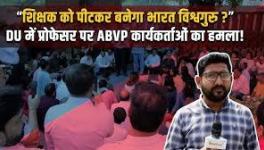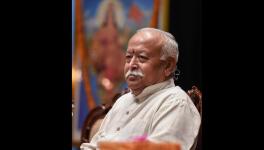Why the Manner of Ram Temple Donation Drive is Worrisome
Image Courtesy: freepress journal
An oft-quoted line from the Koran is also a universal truism and no religion would dispute it: "There must be no coercion in matters of faith!" But, it is also unanimously accepted by those who studied either religion or politics, it is in the terrain of politics where violence or intimidation originates and thereafter, it spills into religion. Very rarely, it is the other way around.
Mahatma Gandhi, used as a moral compass by innumerable political leaders across the globe, including Prime Minister Narendra Modi, did not approve coercive politics. He once said: "Anyone who uses coercion is guilty of deliberate violence. Coercion is inhuman."
Coercion can be explicit, as well as implicit. The Sangh Parivar's month-and-half-long door-to-door donation drive for the Ram temple at Ayodhya, that started in mid-January, was always a coercive campaign, albeit unspoken. The fear of being 'identified' as non-supporters, when 'known' people from the neighbourhood accompanied strangers to come knocking on the door, lurked within even among those given to bravado.
While a significant section of the population remain committed to their idealism and argue they would not donate for reasons of principle, many others reasoned on their own, or after deliberations with friends and family, that it was unwise to get branded as being a person who does not back the Ram temple project. Many either handed out a suitable currency note, or claimed to have already made a donation. Apprehensions of these people merely proved that the Ram Janmabhoomi agitation was never for a temple per se and had little to do with religion. It was always about increasing political clout and establishing religious hegemony.
In fact, this was once openly declared by Bharatiya Janata Party veteran Lal Krishna Advani after the Babri Masjid's demolition. The movement, he asserted, was not to just construct a temple in place of the mosque. Rather, it was to popularise the idea of 'cultural nationalism', euphemism for Hindutva.
Recent reports from several cities that bands of volunteers are affixing stickers on doors of households that paid up, sets the stage for future persecution of people who have a contrarian view of the issue. The worry is that the absence of these stickers on doors of houses in colonies, where the majority sport this badge of religio-cultural fervour, would act as markers in absentia.
History is replete with instances of how mobs methodically targeted homes and business enterprises that were previously physically marked. Numerous tales circulate how the extensively-documented episode, known as Kristallnacht, was planned and executed. In this dark episode, Jewish-owned properties and synagogues were attacked during the pogrom in November 1938 in Germany.
Within India, during the anti-Sikh carnage of 1984, in several colonies of Delhi, Sikh-owned houses were marked and became easy targets when the cold-blooded mobs followed. A similar tactic has been regularly deployed during communal riots in what are termed 'mixed colonies', those where people of all religious communities live. Quite often than not, neighbours have also intimated attackers, pointing out houses which belonged to those from the 'target' community.
The Rashtriya Swayamsevak Sangh (RSS), it is widely acknowledged, runs one of the most well-oiled political machineries in the country with penetration that runs deep in society. As a consequence, when Vishwa Hindu Parishad (VHP) announced in November last year that it planned a fundraising campaign from January 14 for construction of Ram Temple, spread over almost 45 days across India, it was clear that this was a confrontational move aimed at stirring the communal pot.
Even before the campaign was formally initiated, groups that are part of the Hindutva ecosystem, provoked violence in the Malwa region of Madhya Pradesh in December last. Several rallies were taken out and this resulted in violence. The (in)action of district administrations of Indore, Ujjain, Mandsaur and Dhar, served a mere reminder to the Roman statesman, Marcus Tullius Cicero's famous words: "In times of war, the law falls silent."
Instances of the Ram temple supporters affixing stickers on houses of people who are either their own, or have acquiesced to pay up under coercion is the latest in a series of exceedingly problematic developments in a country where secularism remains the mantra of even the current regime.
The decision to donate for the temple or not to pay up is not made by people on the basis of their religious identity. Among Muslims, there will certainly be many who are agreeable to contribute to making a donation. How can one forget that it was one of India's first patriotic poets, Allama Mohammed Iqbal, who referred to Lord Ram as Imam-e-Hind?
It is possible that if the poet was alive, he would have disagreed with the way funds are being raised, a process that evoked fear of identification. Still, there would be many Muslims willing to make an offering for the temple in their personal capacities, for fear or tact.
Likewise, there are countless Hindus across India who are unwilling to contribute to the temple. Their opposition may stem from the political manner in which the construction is being undertaken, with the prime minister performing Bhoomi Pujan, his former principal secretary being a vital member of the Trust that is overseeing the project and the President kicking off the donation drive with an offering when the VHP delegation went to Rashtrapati Bhavan before heading anywhere else.
Hindus unwilling to donate for the temple may also disagree with the Supreme Court verdict which, after declaring the demolition of the Babri Masjid as unlawful, provided relief to the Hindu plaintiffs.
From the time the Ramjanabhoomi movement gathered momentum in the late 1980s, the effort was to depict the 'cause' as 'national'. The agitation for the Ram temple was called a "symbol of national aspiration." There was no room for anyone with different ideas; from the very beginning, opponents of the agitation were intimidated as well as vilified.
Hindustan mein rahna hoga, to Ram ka naam lena hoga and Jo Ram ka nahi, woh kisi kaam ka nahi were among popular slogans of the agitation. In fact, the latter slogan has been set to a raucous song and is a popular draw at programmes connected with the Ram temple.
The targeting of people, either Muslims or Hindus who do not support the principal demands of the Ram temple movement and the manner in which it was allowed to polarise India, is not a new development.
But door-to-door marking while recording names and addresses of people who refused to make a donation raises the possibility of them coming in harm's way in future. In a normal polity, efforts that open up the door to social vigilantism, should be condemned by leaders of these brigades. But, on February 13, RSS chief Mohan Bhagwat directed his cadre that "not a single household should be missed."
The campaign and the concerted efforts of the Sangh Parivar top brass to keep people's involvement alive, indicates that more than six-and-half years after Modi assumed office, the regime has little to bank on for a positive endorsement from people. Ram Mandir, was and remains its primary political weapon. The worry, however, is that the donation drive will enable the Sangh Parivar to put together a massive data base of its supporters and detractors.
Get the latest reports & analysis with people's perspective on Protests, movements & deep analytical videos, discussions of the current affairs in your Telegram app. Subscribe to NewsClick's Telegram channel & get Real-Time updates on stories, as they get published on our website.
























